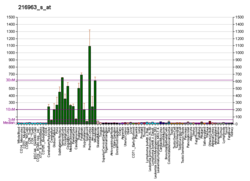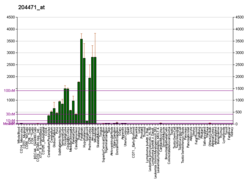Growth Associated Protein 43 (GAP43) is a protein encoded by the GAP43 gene[5] in humans.
| GAP43 | |||||||||||||||||||||||||||||||||||||||||||||||||||
|---|---|---|---|---|---|---|---|---|---|---|---|---|---|---|---|---|---|---|---|---|---|---|---|---|---|---|---|---|---|---|---|---|---|---|---|---|---|---|---|---|---|---|---|---|---|---|---|---|---|---|---|
| |||||||||||||||||||||||||||||||||||||||||||||||||||
| Identifiers | |||||||||||||||||||||||||||||||||||||||||||||||||||
| Aliases | GAP43, B-50, PP46, growth associated protein 43, GAP-43 | ||||||||||||||||||||||||||||||||||||||||||||||||||
| External IDs | OMIM: 162060; MGI: 95639; HomoloGene: 1545; GeneCards: GAP43; OMA:GAP43 - orthologs | ||||||||||||||||||||||||||||||||||||||||||||||||||
| |||||||||||||||||||||||||||||||||||||||||||||||||||
| |||||||||||||||||||||||||||||||||||||||||||||||||||
| |||||||||||||||||||||||||||||||||||||||||||||||||||
| |||||||||||||||||||||||||||||||||||||||||||||||||||
| Wikidata | |||||||||||||||||||||||||||||||||||||||||||||||||||
| |||||||||||||||||||||||||||||||||||||||||||||||||||
GAP43 is called a "growth" or "plasticity" protein because it is expressed at high levels in neuronal growth cones during development[6] and axonal regeneration, and it is phosphorylated after long-term potentiation and after learning.[citation needed]
GAP43 is a crucial component of the axon and presynaptic terminal. Its null mutation leads to death within days after birth, due to axon pathfinding defects.[7]
Synonyms
editGAP43 is also referred to as:
- protein F1
- neuromodulin
- neural phosphoprotein B-50
- axonal membrane protein GAP-43
- calmodulin-binding protein P-57
- nerve growth-related peptide GAP43
- neuron growth-associated protein 43
Function
editGAP43, is a nervous tissue-specific cytoplasmic protein that can be attached to the membrane via a dual palmitoylation sequence on cysteines 3 and 4. This sequence targets GAP43 to lipid rafts. It is a major protein kinase C (PKC) substrate and is considered to play a key role in neurite formation, regeneration, and plasticity.[8][9] The role of GAP-43 in CNS development is not limited to effects on axons: It is also a component of the centrosome, and differentiating neurons that do not express GAP-43 show mislocalization of the centrosome and mitotic spindles, particularly in neurogenic cell divisions. As a consequence, in the cerebellum, the neuronal precursor pool fails to expand normally and the cerebellum is significantly smaller.[10]
Several different laboratories studying the same protein, now called GAP43, initially used different names. It was designated F1, then B-50, then GAP43, pp46, and finally neuromodulin, each name reflecting a different function of the same molecule.[11] F1 was localized to synapses, and was increased in its phosphorylation one day after learning. However, F1 was not cAMP kinase dependent. B-50 was regulated by the pituitary peptide ACTH and was associated with grooming behavior. In the case of GAP-43, it was designated as a growth-associated protein because its synthesis was upregulated during axonal regeneration. Pp46 was concentrated in neuronal growth cones and was thus postulated to play an important role in brain development. In the case of neuromodulin, it was shown to bind calmodulin avidly.
GAP43, the consensus choice for its designation,[11] is a nervous system-specific protein that is attached to the membrane via a dual palmitoylation sequence on cysteines 3 and 4, though it can exist in the non-bound form in the cytoplasm. This dual sequence enables the association of phosphatidylinositol-4,5-bisphosphate [PI(4,5)P2] or PIP2, with actin, facilitating the latter's polymerization thereby regulating neuronal structure. This can occur within a lipid raft so as to compartmentalize and localize motility of filopodia in growth cones in developing brains, and could also remodel presynaptic terminals in adults in an activity-dependent manner. GAP-43 is also a protein kinase C (PKC) substrate. Phosphorylation of serine-41 on GAP-43 by PKC regulates neurite formation, regeneration, and synaptic plasticity.[8]
Because of the association and potential binding of GAP43 with a number of different molecules, including PKC, PIP2, actin, calmodulin, spectrin, palmitate, synaptophysin, amyloid and tau protein, it may be useful to think of GAP43 as an adaptor protein situated within the terminal in a supramolecular complex regulating presynaptic terminal functions, particularly bidirectional communication with the postsynaptic process. Its important role in memory and information storage is executed through its cell biological mechanisms of phosphorylation, palmitoylation, protein-protein interaction and structural remodeling via actin polymerization.
Clinical significance
editHumans with a deletion in one allele of the GAP43 gene fail to form telencephalic commissures and are intellectually disabled.[12][13]
References
edit- ^ a b c GRCh38: Ensembl release 89: ENSG00000172020 – Ensembl, May 2017
- ^ a b c GRCm38: Ensembl release 89: ENSMUSG00000047261 – Ensembl, May 2017
- ^ "Human PubMed Reference:". National Center for Biotechnology Information, U.S. National Library of Medicine.
- ^ "Mouse PubMed Reference:". National Center for Biotechnology Information, U.S. National Library of Medicine.
- ^ Kosik KS, Orecchio LD, Bruns GA, Benowitz LI, MacDonald GP, Cox DR, Neve RL (Apr 1988). "Human GAP-43: its deduced amino acid sequence and chromosomal localization in mouse and human". Neuron. 1 (2): 127–32. doi:10.1016/0896-6273(88)90196-1. PMID 3272162. S2CID 12067138.
- ^ Referenced within : Rosskothen-Kuhl N, Illing RB (2014). "Gap43 Transcription Modulation in the Adult Brain Depends on Sensory Activity and Synaptic Cooperation". PLOS ONE. 9 (3): e92624. Bibcode:2014PLoSO...992624R. doi:10.1371/journal.pone.0092624. PMC 3960265. PMID 24647228.
- ^ "Entrez Gene: GAP43 growth associated protein 43".
- ^ a b Benowitz LI, Routtenberg A (Feb 1997). "GAP-43: an intrinsic determinant of neuronal development and plasticity". Trends in Neurosciences. 20 (2): 84–91. doi:10.1016/S0166-2236(96)10072-2. PMID 9023877. S2CID 35082372.
- ^ Aarts LH, Schotman P, Verhaagen J, Schrama LH, Gispen WH (1998). "The Role of the Neural Growth Associated Protein B-50/Gap-43 in Morphogenesis". Molecular and Cellular Mechanisms of Neuronal Plasticity. Advances in Experimental Medicine and Biology. Vol. 446. pp. 85–106. doi:10.1007/978-1-4615-4869-0_6. ISBN 978-1-4613-7209-7. PMID 10079839.
- ^ Mishra R, ManiS (2008). "GAP-43 is key to mitotic spindle control and centrosome-based polarization in neurons". Cell Cycle. 7 (3): 348–357. doi:10.4161/cc.7.3.5235. PMID 18235238.
- ^ a b Benowitz LI, Routtenberg A (1987). "A membrane phosphoprotein associated with neural development, axonal regeneration, phospholipid metabolism, and synaptic plasticity". Trends in Neurosciences. 10 (12): 527–532. doi:10.1016/0166-2236(87)90135-4. S2CID 54322365.
- ^ Genuardi M, Calvieri F, Tozzi C, Coslovi R, Neri G (Oct 1994). "A new case of interstitial deletion of chromosome 3q, del(3q)(q13.12q21.3), with agenesis of the corpus callosum". Clinical Dysmorphology. 3 (4): 292–6. doi:10.1097/00019605-199410000-00003. PMID 7894733. S2CID 38716384.
- ^ Mackie Ogilvie C, Rooney SC, Hodgson SV, Berry AC (Mar 1998). "Deletion of chromosome 3q proximal region gives rise to a variable phenotype". Clinical Genetics. 53 (3): 220–2. doi:10.1111/j.1399-0004.1998.tb02681.x. PMID 9630079. S2CID 20499346.
Further reading
edit- Fantini F, Johansson O (Dec 1992). "Expression of growth-associated protein 43 and nerve growth factor receptor in human skin: a comparative immunohistochemical investigation". The Journal of Investigative Dermatology. 99 (6): 734–42. doi:10.1111/1523-1747.ep12614465. PMID 1281863.
- Mercken M, Lübke U, Vandermeeren M, Gheuens J, Oestreicher AB (Apr 1992). "Immunocytochemical detection of the growth-associated protein B-50 by newly characterized monoclonal antibodies in human brain and muscle". Journal of Neurobiology. 23 (3): 309–21. doi:10.1002/neu.480230310. PMID 1385623.
- Spencer SA, Schuh SM, Liu WS, Willard MB (May 1992). "GAP-43, a protein associated with axon growth, is phosphorylated at three sites in cultured neurons and rat brain". The Journal of Biological Chemistry. 267 (13): 9059–64. doi:10.1016/S0021-9258(19)50388-X. PMID 1533624.
- Apel ED, Litchfield DW, Clark RH, Krebs EG, Storm DR (Jun 1991). "Phosphorylation of neuromodulin (GAP-43) by casein kinase II. Identification of phosphorylation sites and regulation by calmodulin". The Journal of Biological Chemistry. 266 (16): 10544–51. doi:10.1016/S0021-9258(18)99258-6. PMID 1828073.
- Apel ED, Byford MF, Au D, Walsh KA, Storm DR (Mar 1990). "Identification of the protein kinase C phosphorylation site in neuromodulin". Biochemistry. 29 (9): 2330–5. doi:10.1021/bi00461a017. PMID 2140056.
- Kosik KS, Orecchio LD, Bruns GA, Benowitz LI, MacDonald GP, Cox DR, Neve RL (Apr 1988). "Human GAP-43: its deduced amino acid sequence and chromosomal localization in mouse and human". Neuron. 1 (2): 127–32. doi:10.1016/0896-6273(88)90196-1. PMID 3272162. S2CID 12067138.
- Ng SC, de la Monte SM, Conboy GL, Karns LR, Fishman MC (Apr 1988). "Cloning of human GAP-43: growth association and ischemic resurgence". Neuron. 1 (2): 133–9. doi:10.1016/0896-6273(88)90197-3. PMID 3272163. S2CID 19627547.
- Nielander HB, De Groen PC, Eggen BJ, Schrama LH, Gispen WH, Schotman P (Sep 1993). "Structure of the human gene for the neural phosphoprotein B-50 (GAP-43)". Brain Research. Molecular Brain Research. 19 (4): 293–302. doi:10.1016/0169-328X(93)90128-C. hdl:1874/4067. PMID 8231732.
- Oehrlein SA, Parker PJ, Herget T (Jul 1996). "Phosphorylation of GAP-43 (growth-associated protein of 43 kDa) by conventional, novel and atypical isotypes of the protein kinase C gene family: differences between oligopeptide and polypeptide phosphorylation". The Biochemical Journal. 317. 317 (1): 219–24. doi:10.1042/bj3170219. PMC 1217466. PMID 8694767.
- Kanazir S, Ruzdijic S, Vukosavic S, Ivkovic S, Milosevic A, Zecevic N, Rakic L (May 1996). "GAP-43 mRNA expression in early development of human nervous system". Brain Research. Molecular Brain Research. 38 (1): 145–55. doi:10.1016/0169-328X(96)00008-3. PMID 8737678.
- de Groen PC, Eggen BJ, Gispen WH, Schotman P, Schrama LH (1996). "Cloning and promoter analysis of the human B-50/GAP-43 gene". Journal of Molecular Neuroscience. 6 (2): 109–19. doi:10.1007/BF02736770. PMID 8746449. S2CID 22911100.
- Chao S, Benowitz LI, Krainc D, Irwin N (Sep 1996). "Use of a two-hybrid system to investigate molecular interactions of GAP-43". Brain Research. Molecular Brain Research. 40 (2): 195–202. doi:10.1016/0169-328X(96)00049-6. PMID 8872303.
- Gamby C, Waage MC, Allen RG, Baizer L (Oct 1996). "Analysis of the role of calmodulin binding and sequestration in neuromodulin (GAP-43) function". The Journal of Biological Chemistry. 271 (43): 26698–705. doi:10.1074/jbc.271.43.26698. PMID 8900147.
- Heuss D, Schlötzer-Schrehardt U (Jun 1998). "Subcellular localization of phosphoprotein B-50 in regenerating muscle. An immuno-electron microscopic study". Neurological Research. 20 (4): 360–4. doi:10.1080/01616412.1998.11740532. PMID 9618702.
- Neve RL, Coopersmith R, McPhie DL, Santeufemio C, Pratt KG, Murphy CJ, Lynn SD (Oct 1998). "The neuronal growth-associated protein GAP-43 interacts with rabaptin-5 and participates in endocytosis". The Journal of Neuroscience. 18 (19): 7757–67. doi:10.1523/JNEUROSCI.18-19-07757.1998. PMC 6793001. PMID 9742146.
- Arni S, Keilbaugh SA, Ostermeyer AG, Brown DA (Oct 1998). "Association of GAP-43 with detergent-resistant membranes requires two palmitoylated cysteine residues". The Journal of Biological Chemistry. 273 (43): 28478–85. doi:10.1074/jbc.273.43.28478. PMID 9774477.
- Eastwood SL, Harrison PJ (Sep 1998). "Hippocampal and cortical growth-associated protein-43 messenger RNA in schizophrenia". Neuroscience. 86 (2): 437–48. doi:10.1016/S0306-4522(98)00040-2. PMID 9881859. S2CID 41460546.
- Cargill M, Altshuler D, Ireland J, Sklar P, Ardlie K, Patil N, Shaw N, Lane CR, Lim EP, Kalyanaraman N, Nemesh J, Ziaugra L, Friedland L, Rolfe A, Warrington J, Lipshutz R, Daley GQ, Lander ES (Jul 1999). "Characterization of single-nucleotide polymorphisms in coding regions of human genes". Nature Genetics. 22 (3): 231–8. doi:10.1038/10290. PMID 10391209. S2CID 195213008.
- Riederer BM, Routtenberg A (Aug 1999). "Can GAP-43 interact with brain spectrin?". Brain Research. Molecular Brain Research. 71 (2): 345–8. doi:10.1016/S0169-328X(99)00179-5. PMID 10521589.
- Vento P, Soinila S (Nov 1999). "Quantitative comparison of growth-associated protein GAP-43, neuron-specific enolase, and protein gene product 9.5 as neuronal markers in mature human intestine". The Journal of Histochemistry and Cytochemistry. 47 (11): 1405–16. doi:10.1177/002215549904701107. PMID 10544214.
External links
edit- Gap-43+protein at the U.S. National Library of Medicine Medical Subject Headings (MeSH)
- ihop-net, Growth associated protein 43
- NCBI





